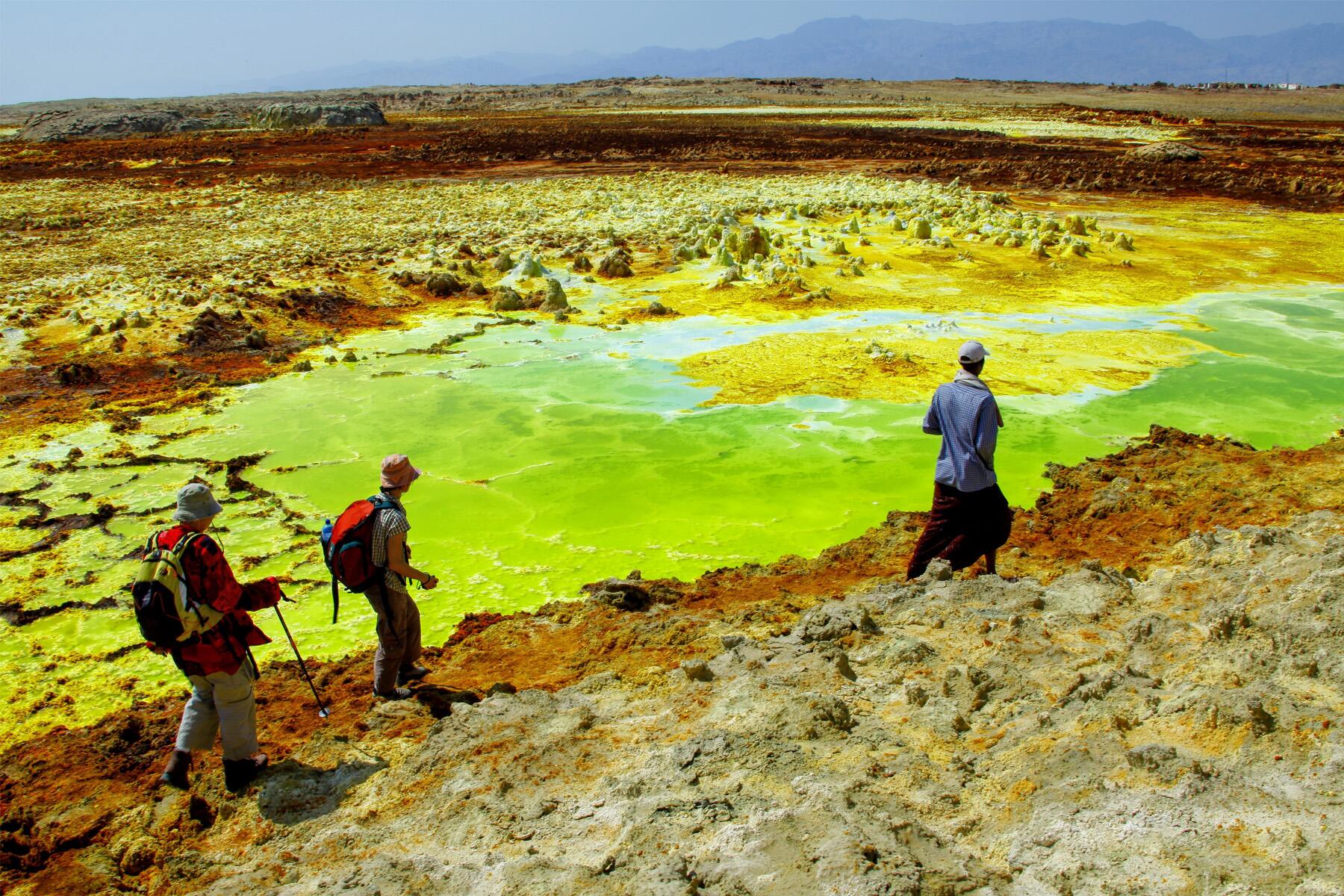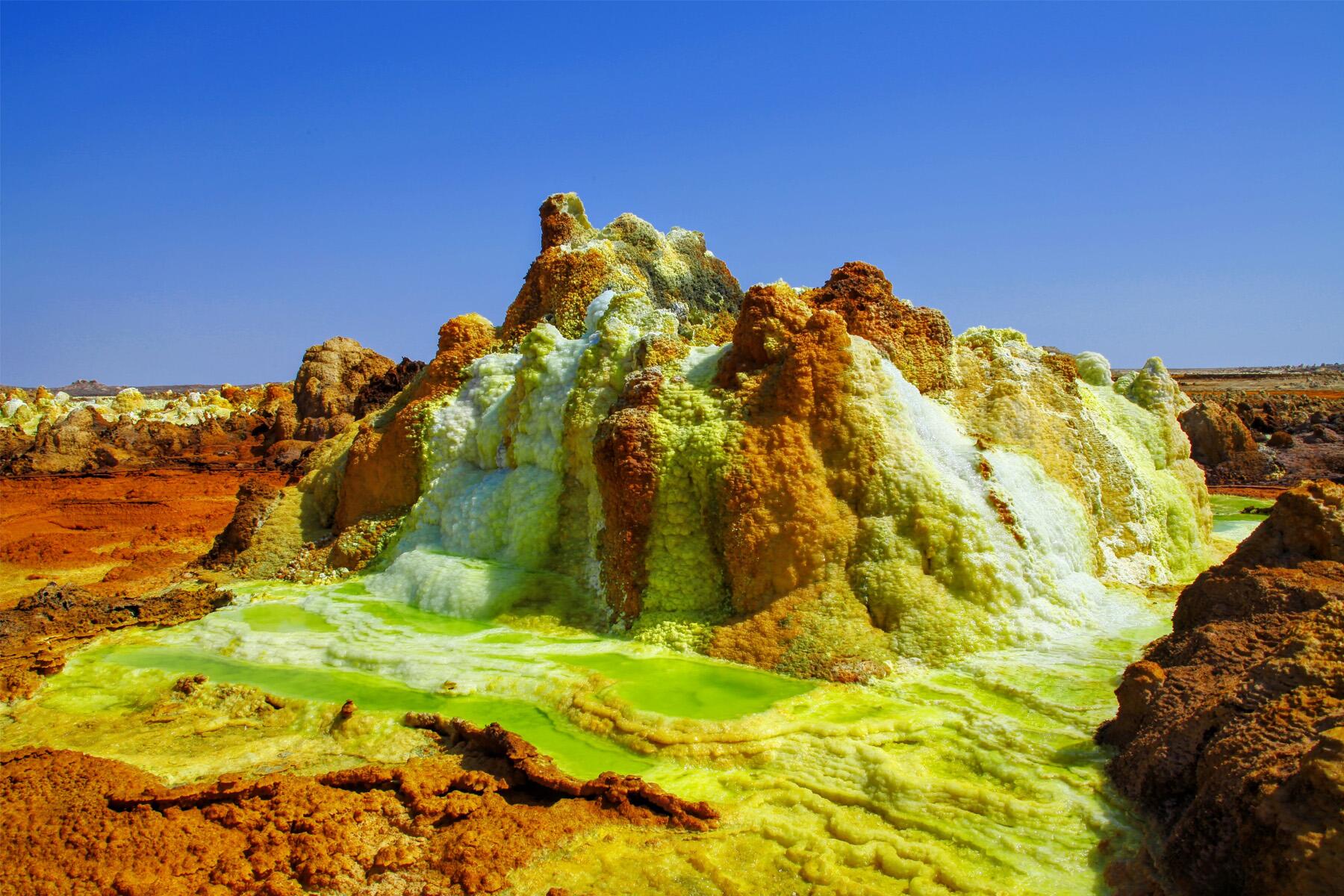One of the world’s harshest environments is also one of its most fascinating.
A pungent smell choked the air and breathing into a ruched-up scarf pressed firmly over the nose barely offered any respite. Liquid in unearthly luminous yellow-and-green hot springs scattered around the vicinity spluttered and hissed like simmering cauldrons of puke as sulfur and iron mixed, eyes watering from the emissions. We were under stern instructions not to touch the liquid as the chemicals could sizzle one’s skin like fried bacon. A flock of birds fluttered above, unperturbed, a puzzling sight in what may well be one of the harshest corners of the world. Set in northern Ethiopia bordering Eritrea and Djibouti, the Danakil Depression has a fascinating topography and has earned world titles such as the hottest (annual temperatures here average 122 degrees Fahrenheit) and one of the lowest (426 feet below sea level) places on earth.

We followed our lithe shuka-clad guide who had an AK-47 casually slung over his shoulder as he led the way past a geyser to yet another acidic pool, the landscape dramatically changing from yellow, maroon, orange, green, pink, and white to brown like a painting accidentally created by an unmonitored toddler. In the local Afar language, the name of this area is “Dallol” which aptly translates to “colorful stone.”
Recommended Fodor’s Video
Set in northern Ethiopia bordering Eritrea and Djibouti, the Danakil Depression has a fascinating topography and has earned world titles such as the hottest and one of the lowest places on earth.
A guide, porter, two other travelers, and I all bundled back onto our white jeep which then tore across the salt pan at a speed that was probably illegal, blasting Amharic pop music on the car’s radio and shimmying like Ethiopian traditional dances demand. We came to a stop at a green natural plunge pool in the middle of the desert, its shape either resembling a crooked heart or the African map depending on your vantage point. This “crack in the earth,” which initially puzzled the locals, was tiny when it was first spotted two years ago but has slowly been expanding, and they have now concluded that it is safe to swim in. Swimsuits were discreetly changed into behind the jeep then we made our way to the edge of the pool, gingerly feeling our way in because of the sharp jagged edges which nipped the skin if you went too close. Once in the water, the body is surprisingly buoyant, naturally pushed to float on the surface as though in the Dead Sea, a quality attributed to the high salinity of the water and the Danakil’s low point on the earth.

Cold Habesha beers were passed around from a cooler box and the next hour was spent floating about in a blissful zen-like state until a few more jeeps arrived and eager tourists tumbled out with cameras; the magic was broken. Our guide quickly hosed us down using a shower head whose opposite end was plunged into a bucket, the cold water trickling down our dried-out skin and dissolving salt ground beneath bare feet. As the others changed into dry clothes, I climbed up a red salt hill a few feet from the pool taking barely 10 minutes to get to the top and walk its geometrically cracked length. This is considered a holy mountain and Afar tribesmen believe that if it ever disappears, there will be no salt in the Danakil Depression. For that reason, they don’t mine it. The pool’s water comes from Lake Asale whose shores are about two miles away, the entire view so white under a blazing sun that it’s like staring right into a spotlight, but softened under a romantic orange dusk, the reflection over the evenly shallow water is sublime.

The night was spent at the outdoor Hamed Ela camp which sits within a bustling Afar community. Being nomadic, their homesteads are usually temporary dome or rectangular structures made with readily available materials such as sticks with any gaps covered with polythene or pieces of patched hand-woven cloths. These houses are easy to demolish and carry to the next location when they need to move, and the only contemporary addition to the design is iron sheet doors. Goats as resilient as their owners milled about the compound. “Where can I take a quick shower?” I asked the guide. “No shower!” he exclaimed in bemusement. For toilets, he simply pointed behind a hut facing the busy tarmac road.
We were only woken up by the first truck passing by at 5 a.m. and the guide telling us it was time to have breakfast and get going since “only children are allowed to still be asleep at this hour.”
A flashlight beamed in the pitch darkness illuminating the way to a makeshift dining area with a hidden kitchen from which a lot of smoke billowed. A chef with a smart white coat and headlamp emerged with a platter of the Ethiopian staple dish, injera, a sour flatbread made from teff flour fermented for several days then baked on a griddle, accompanied by a spicy chickpea sauce called shiro. Eight narrow beds which could be mistaken for benches were neatly lined in the open, each with a new mattress, thin multicolored blanket, and pillow. We would be sleeping under the stars. The cold mercifully kept at bay and aside from having to strategically turn over in the middle of the night so as not to topple over the edge of the bed, we were only woken up by the first truck passing by at 5 a.m. and the guide telling us it was time to have breakfast and get going since “only children are allowed to still be asleep at this hour.”

One of 86 tribes in Ethiopia, we had been told that the Afar had a reputation for not being the most welcoming, much like their environment in the Danakil Depression. At 10 a.m. the next morning we walked up to a group of about 30 men mining salt from the earth under a sun so scorching I felt I might pass out. One was shirtless; thin yet muscular, with only a shuka tied around his waist, sandals on his feet and a gym glove on his right hand which he was using to chisel a block of salt into a rectangular shape while his companion in green linen pants and a striped T-shirt tied the completed blocks together to be loaded onto camels and donkeys which were resting nearby. These would be transported to Berhale, a three-hour trek away, or a longer camel caravan to the Tigray Highlands some 10 to 76 hours away. The shirtless miner decided to take a break and started unpacking his lunch, and when he caught me staring at him, he invited me to join. We exchanged a few pleasantries in basic English. Soon it was time to leave for Mekele City, but for one other traveler, a trek to the active Erta Ale “smoking mountain” volcano awaited.



